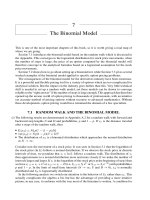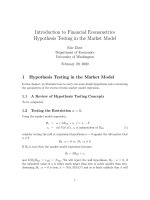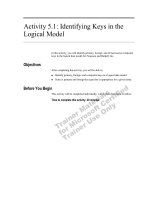The Binomial Model
Bạn đang xem bản rút gọn của tài liệu. Xem và tải ngay bản đầy đủ của tài liệu tại đây (294.7 KB, 12 trang )
7
The Binomial Model
This is one of the most important chapters of this book, so it is worth giving a road map of
where we are going.
Section 7.1 introduces the binomial model based on the random walk which is discussed in
the Appendix. This converges to the lognormal distribution for stock price movements, when
the number of steps is large; the price of an option computed by the binomial model will
therefore converge to the analytical formulas based on a lognormal assumption for the stock
price movements.
Section 7.2 shows how to go about setting up a binomial tree while Section 7.3 gives several
worked examples of the binomial model applied to specific option pricing problems.
The consequences of the binomial model for the derivatives industry have been enormous.
It is a powerful and flexible pricing tool for a variety of options which are too complicated for
analytical solution. But the impact on the industry goes further than this. Very little technical
skill is needed to set up a random walk model; yet these models can be shown to converge
reliably to the “right answer” if the number of steps is large enough. This approach has therefore
opened up the arcane world of option pricing to thousands of professionals, with an intuitive
yet accurate method of pricing options without recourse to advanced mathematics. Without
these developments, option pricing would have remained the domain of a few specialists.
7.1 RANDOM WALK AND THE BINOMIAL MODEL
(i) The following results are demonstrated in Appendix A.2 for a random walk with forward and
backward step lengths U and D and probabilities p and 1 − p.Ifx
n
is the distance traveled
after n steps of the random walk, then
r
E
[
x
N
]
= N {pU − (1 − p)D}
r
var
[
x
N
]
= Np(1 − p)(U + D)
2
r
The distribution of x
N
is a binomial distribution which approaches the normal distribution
as N →∞.
Consider now the movement of a stock price. It was seen in Section 3.1 that the logarithm of
the stock price (ln S
t
) follows a normal distribution. If we observe the stock price at discrete
intervals of time, we postulate that x
i
= ln S
i
follows a random walk. The distribution of x
i
then approximates to a normal distribution more and more closely if we make the number of
intervals larger and larger. If x
i
is the logarithm of the stock price at the beginning of step i then
we have x
i+l
= x
i
+ U or x
i+l
= x
i
− D (i.e. S
i+l
= S
i
e
U
or S
i+l
= S
i
e
−D
) with probabilities
p and 1 − p. In the limit of small time intervals (N →∞; U and D → 0), x
N
is normally
distributed and S
N
is lognormally distributed.
In the following analysis we switch our attention to the behavior of S
N
rather than x
N
. This
actually complicates the algebra a bit, but has the advantage of providing a more intuitive
picture; in any case, it conforms with the way most of the literature is written. A condition for
7 The Binomial Model
x
N
to approach a normal distribution is that U and D are constants; the corresponding condition
for S
N
to approach the lognormal distribution is that u = e
U
and d = e
−D
should be constant
multiplicative factors. The progress of x
N
is described as an arithmetic random walk, while
S
N
follows a geometric random walk.
t
dd
t
d
d
f
0
0
S
0
f
d
S
=
dS
0
0
f
u
S=uS
0
Figure 7.1 Two possible final states
(ii) Single Step Binomial Model: A description of the
binomial model starts with the simple one-step ex-
ample of Section 4.1.
Suppose the stock and derivative start with prices
S
0
and f
0
. After a time interval δt, S
δ
t
has one of
two possible values, S
u
or S
d
, with corresponding
derivative prices f
u
and f
d
(Figure 7.1).
If a perfect hedge can be formed between one
unit of derivative and units of stock, we saw in
Section 4.1(iv) that the no-arbitrage condition im-
poses the following condition:
f
u
− S
u
= f
d
− S
d
= (1 + r δt)(f + S)
We find it simpler to manipulate the interest term in continuous form, although many authors
develop the theory in the form just given. For small time steps and to first order in δt, the
results are the same. These equations can then be rewritten as
S
0
= e
−r
δ
t
( pS
u
+ (1 − p)S
d
); f
0
= e
−r
δ
t
( pf
u
+ (1 − p) f
d
)
=
f
u
− f
d
S
u
− S
d
; p =
S
0
e
r
δ
T
− S
d
S
u
− S
d
(7.1)
It is critically important to realize that we have not started by defining p as the probability of an
up-move. We have started from the no-arbitrage equations in which a parameter p appears. It
happens to have the general “shape” of a probability and is interpreted as the pseudo-probability
(i.e. probability in a risk-neutral world) that S
0
moves to S
u
in the period δt.
If continuous dividends were taken into account, we would make the substitution S
δ
t
→
S
δ
t
e
−q
δ
t
in the first equation and p would then be given by
p =
F
0
δ
t
− S
d
S
u
− S
d
where F
0
δ
t
= S
0
e
(r−q)
δ
t
is the forward rate.
(iii) Conditions on Drift and Variance: Values can be obtained for u, d and p from a knowledge
of the mean and variance of S
δ
t
. Writing S
u
= uS
0
and S
d
= dS
0
and interpreting p as the
probability of an up-move in a risk-neutral world, the mean and variance of S
δ
t
may be written
E[S
δ
t
] ={pS
u
+ (1 − p)S
d
}=S
0
{ pu + (1 − p)d}
var[S
δ
t
] =
pS
2
u
+ (1 − p)S
2
u
− E
2
[S
δ
t
] = S
2
0
p(1 − p)(u − d)
2
(7.2)
Recall the following results derived in Section 3.2(ii) and applied to a risk-neutral world:
E[S
δ
t
] = S
0
e
(r−q)
δ
t
= F
0
δ
t
; var[S
δ
t
] = E
2
[S
δ
t
]{e
σ
2
δ
t
− 1}≈F
2
0
δ
t
σ
2
δt + O[δt
2
]
76
7.2 THE BINOMIAL NETWORK
Equating these last two sets of equations and dropping terms of higher order in δt gives
F
0
δ
t
= S
0
{ pu + (1 − p) d}; F
2
0
δ
t
σ
2
δt = S
2
0
p(1 − p)(u − d)
2
(7.3)
These are two equations in three unknowns (u, d and p), so there is leeway to choose one of
the parameters; is there any constraint in this seemingly arbitrary choice?
From the first relationship, it is clear that if S
u
(= uS
0
) and S
d
(= dS
0
) do not straddle F
0
δ
t
,
then either p or (1 − p) must be negative. Since we wish to interpret p as a probability (albeit
in a risk-neutral world), we must impose the condition S
d
< F
0
δ
t
< S
u
.
The function p(1 − p) has a maximum at p =
1
2
. The second of equations (7.3) above
therefore yields the following inequality:
F
0
δ
t
σ
√
δt
S
u
− S
d
≤
1
2
(7.4)
This is really saying that if the spread S
u
− S
d
is not chosen large enough, the random walk
will not be able to approximate a normal distribution with volatility σ .
(iv) Relationship with Wiener Process: Another way of looking at the analysis of the last para-
graph is to say that the Wiener process S
t+
δ
t
− S
t
= δS
t
= S
t
(r − q)δt + S
t
σ
√
δtz can be
represented by one step in a binomial process, where z is a standard normal variate so that
E[S
δ
t
] = S
0
(1 + (r − q) δt) and var[S
δ
t
] = S
2
0
σ
2
δt.
We must now choose u, d and p to match these, i.e.
E[S
δ
t
] = S
0
(1 + (r − q)δt) = S
0
( pu + (1 − p)d)
var[S
δ
t
] = S
2
0
σ
2
δt = S
2
0
p (1 − p)(u − d)
2
(7.5)
The reader may very well object at this point since this seems to be the wrong answer; equations
(7.3) and (7.5) are not quite the same. But recall that the entire Ito analysis is based on rejection
of terms of order higher than δt:
F
0
δ
t
= S
0
e
(r−q)
δ
t
= S
0
{1 + (r − q) δt}+O[δt
2
]; F
0
δ
t
σ
√
δt = S
0
σ
√
δt + O[
√
δt
3
]
To within this order, the results of this and the last subparagraph are therefore equivalent.
7.2 THE BINOMIAL NETWORK
(i) The stock price movement over a single step of length δt is of little use in itself. We need to
construct a network of successive steps covering the entire period from now to the maturity of
the option; the beginning of one such network is shown in Figure 7.2.
The procedure for using this model to price an option is as follows:
(A) Select parameters u, d and p which conform to equation (7.2). The most popular ways of
doing this are described in the following subparagraphs.
(B) Using these values of u and d, work out the possible values for the stock price at the final
nodes at t = T . We could work out the stock value for each node in the tree but if the tree
is European, we only need the stock values in the last column of nodes.
(C) Corresponding to each of the final nodes at time t = T , there will be a stock price S
m,T
where m indicates the specific node in the final column of nodes.
77
7 The Binomial Model
(D) Assume the derivative depends only on the final stock price. Corresponding to the stock
price at each final node, there will be a derivative payoff f
m,T
(S
T
).
(E) Just as each node is associated with a stock price, each node has a derivative price. The
nodal derivative prices are related to each other by the repeated use of equations (7.1).
Looking at Figure 7.2 we have
f
4
= e
−r
δ
t
{ pf
7
+ (1 − p) f
8
}
f
5
= e
−r
δ
t
{ pf
8
+ (1 − p) f
9
}
.
.
.
f
2
= e
−r
δ
t
{ pf
4
+ (1 − p) f
5
}
.
.
.
This sequence of calculations allows the present value of the option, f
0
, to be calculated from
the payoff values of the option, f
m,T
(S
T
); this is commonly referred to as “rolling back through
the tree”.
(ii) Jarrow and Rudd: There remains the question of our choice of u, d and p. The options are
examined for a simple arithmetic random walk in Appendix A.2(v); we now develop the
corresponding theory for a geometric random walk.
t = 0 t = T
0
1
3
6
2
4
5
7
8
9
m, t
S
0
S
0
uS
0
dS
2
0
uS
0
S
0
S
2
0
dS
3
0
uS
2
0
udS
2
0
ud S
3
0
dS
0
uS
0
dS
m, T
final stock
prices
S
Figure 7.2 Binomial tree (Jarrow–Rudd)
The most popular choice is to put u = d
−1
, giving the same proportional move up and down.
Writing u = d
−1
= e
, substituting in equations (7.5) and rejecting terms higher than δt gives
= σ
√
δt. The pseudo-probability of an up-move is then given by
p =
e
(r−q)
δ
t
− e
−σ
√
δ
t
e
σ
√
δ
t
− e
−σ
√
δ
t
≈
1 + (r − q) δt −
1 − σ
√
δt +
1
2
σ
2
δt
1 + σ
√
δt +
1
2
σ
2
δt
−
1 − σ
√
δt +
1
2
σ
2
δt
≈
1
2
+
1
2
r − q −
1
2
σ
2
σ
√
δt (7.6)
Apart from its simplicity of form, this choice is popular because u = d
−1
. The effect of this
is that in Figure 7.2, S
4
= udS
0
= S
0
. In other words, the center of the network remains at a
constant S
0
. Compare this formula for p with the corresponding result for an arithmetic random
78
7.2 THE BINOMIAL NETWORK
walk given by equation (A2.7). An extra term
1
2
σ
2
has appeared in the drift, which typically
happens when we move from a normal distribution to a lognormal one.
Final stock prices merely take the values
S
0
e
−N σ
√
δ
t
, S
0
e
−(N−1)σ
√
δ
t
, ..., 0,...,S
0
e
N σ
√
δ
t
where N is the number of steps in the model.
(iii) Cox, Ross and Rubinstein: An alternative, popular arrangement of S
u
and S
d
is to start the
other way round: specify the pseudo-probability as p =
1
2
and derive a compatible pair u and
d. Putting p =
1
2
in equations (7.3) gives
S
0
1
2
u +
1
2
d
= F
0
δ
t
or S
0
(u + d) = 2 F
0
δ
t
1
2
1 −
1
2
S
2
0
(u − d)
2
= F
2
0
δ
t
σ
2
δt or S
0
(u − d) = 2 F
0
δ
t
σ
√
δt
The equations on the right immediately yield
u =
F
0
δ
t
S
0
(1 + σ
√
δt); d =
F
0
δ
t
S
0
(1 − σ
√
δt) (7.7)
The binomial network for these values is shown in Figure 7.3. The probability of an up-move
or a down-move at each node is now
1
2
. The center line of the network is no longer horizontal,
but slopes up. At node 4 in the diagram the stock price is
S
center,2
δ
t
= S
4
= udS
0
= S
0
e
(r−q)2
δ
t
(1 − σ
√
δt)(1 + σ
√
δt)
= S
0
e
(r−q)2
δ
t
1 −
1
2
σ
2
2δt
= S
0
e
(r−q)2
δ
t
1 −
1
2
σ
2
T
N/2
There are N steps altogether so that δt = T /N , and the center line S
center
has equation
S
center,T
= S
0
e
(r−q)T
1 −
1
2
σ
2
T
N/2
N/2
→ exp
r − q −
1
2
σ
2
T as N →∞
t = 0 t = T
S
center
0
1
2
3
4
5
Final Stock
Prices S
m
,
T
S
m
,
t
Figure 7.3 Binomial tree (Cox–Ross–Rubinstein)
79









